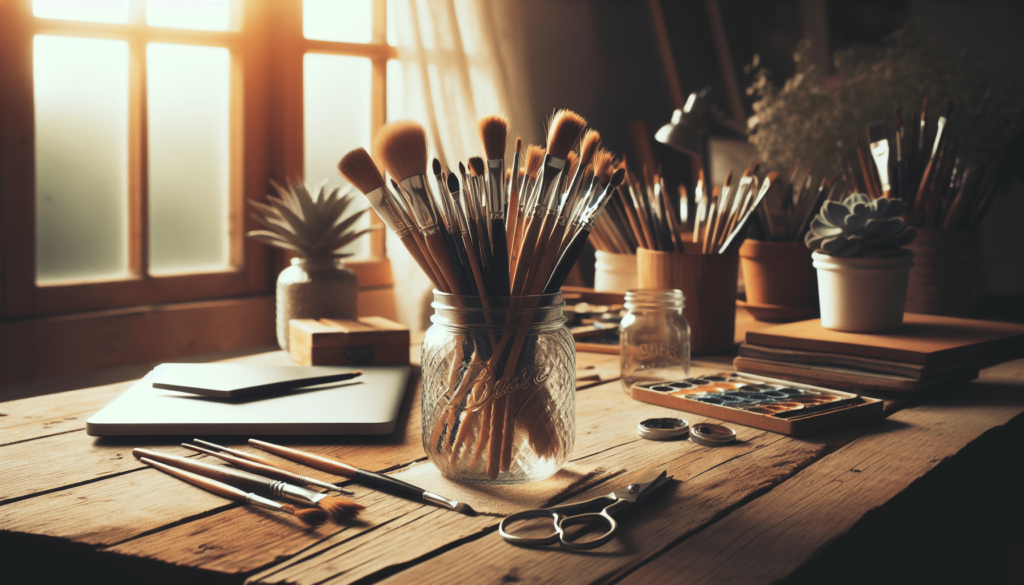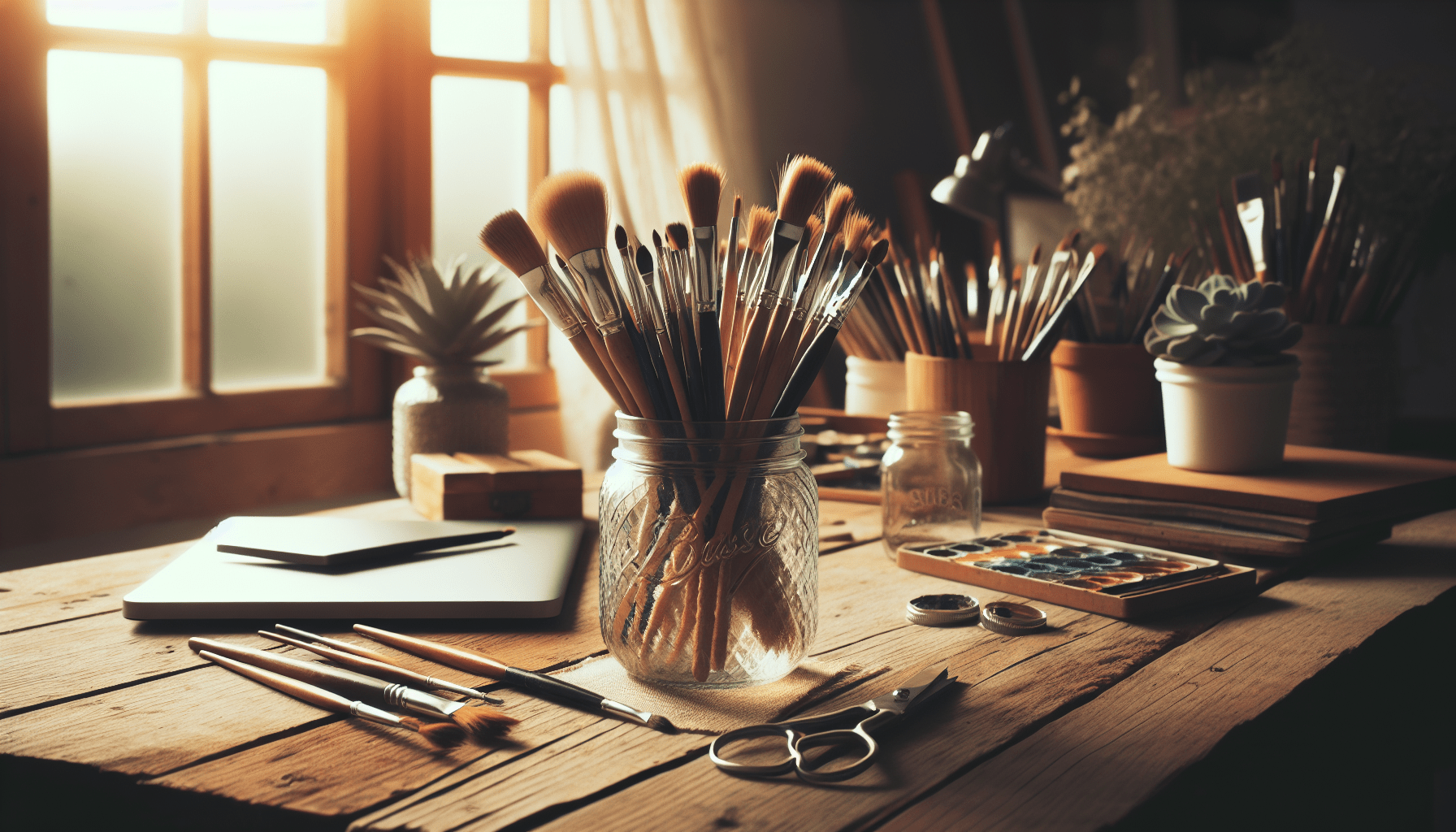When it comes to storing paint brushes overnight, it is essential to adopt proper techniques to preserve their quality and ensure their longevity. This article will guide you through the best practices for storing paint brushes overnight, sharing expert tips and tricks that will minimize bristle damage and prevent the hardening of dried paint. By following these simple yet effective methods, you can maintain the integrity of your paint brushes and extend their lifespan, ultimately saving you time and money in the long run.
Cleaning the Brushes
When it comes to properly storing paint brushes, it is essential to start by cleaning them thoroughly. Before storing your brushes, you need to remove any excess paint by gently scraping the bristles against the edge of the paint can or a disposable surface. This step will prevent the paint from drying and hardening on the bristles, which can be difficult to remove later on.
After removing excess paint, you should rinse the brushes with warm water. The warm water helps to loosen any remaining paint and keeps the bristles soft and pliable. Make sure to rinse the brushes thoroughly, ensuring that all the paint particles are removed. Improperly cleaned brushes can lead to stiff or clumped bristles, compromising their performance.
To achieve a more thorough cleaning, it is advisable to use mild soap or a brush cleaner specifically designed for paint brushes. Gently lather the bristles with the soap or cleaner, working it in with your fingers or a soft brush. This step will help remove any residual paint or stains while also keeping the bristles conditioned. Rinse the brushes again with warm water to remove any soap or cleaner residue.
Once the brushes have been cleaned, it is important to pat them dry with a clean cloth or paper towel. Avoid rubbing the bristles vigorously, as this can cause damage. Instead, gently squeeze the bristles and blot them to remove excess moisture. Properly drying the brushes will help prevent mold or mildew growth and maintain their shape.
Preserving Brush Shape
Maintaining the shape of your paint brushes is crucial for ensuring their longevity and optimal performance. Reshaping the bristles after cleaning them is a vital step in preserving a brush’s shape. While the bristles are still damp, gently reshape them with your fingers, ensuring they are back to their original form. This step is particularly important for brushes with natural bristles, as they tend to lose their shape more easily.
To further protect the shape of your brushes, consider using a brush cover or wrap. These protective covers are typically made from breathable materials that allow the brushes to dry while keeping their shape intact. Brush covers or wraps also prevent dust and debris from accumulating on the bristles, ensuring that the brushes are ready for use whenever you need them.
Utilizing brush holders or containers can also contribute to maintaining brush shape. These holders provide individual compartments for each brush, preventing them from touching or rubbing against each other, which can cause deformation. By storing your brushes in holders or containers, you create a designated space for each brush, preventing any unintentional damage.
Another effective method for preserving brush shape is to hang brushes vertically. This storage technique helps the bristles retain their natural position and prevents bending or warping. By hanging the brushes, you also ensure that dust and debris do not settle onto the bristles, keeping them clean and ready for immediate use.

Avoiding Damage
To extend the lifespan of your paint brushes, it is crucial to be mindful of potential sources of damage. Bristles are delicate and can easily bend, which leads to poor brush performance. To protect the bristles from bending, avoid pressing them against hard surfaces or storing brushes with excessive pressure. Be careful when placing brushes into holders or containers, ensuring that the bristles are not crushed or squashed.
Direct sunlight should also be avoided when storing brushes. Prolonged exposure to sunlight can cause the bristles to become dry and brittle, resulting in a loss of their natural softness and flexibility. Instead, choose a storage location away from direct sunlight, such as a closet or a drawer.
Extreme temperatures can also have adverse effects on the bristles of paint brushes. Both excessive heat and extreme cold can cause the bristles to become brittle or even melt, rendering the brushes unusable. To prevent this, store your brushes in a climate-controlled area, ideally at room temperature. Avoid storing brushes in areas subject to extreme temperature changes, such as attics or basements.
Proper Storage Solutions
Choosing suitable storage solutions is crucial for maintaining the condition and longevity of your paint brushes. When selecting a container for storing your brushes, it is important to consider the size and shape of the brushes. Opt for a container that allows each brush to be stored individually, preventing them from touching or rubbing against each other.
To provide additional protection, consider using brush sleeves or tubes. These sleeves are typically made of soft, non-abrasive materials that shield the bristles from dust, dirt, and potential damage. By sliding each brush into its own sleeve or tube, you create a barrier that prevents unwanted contact and maintains the brushes’ cleanliness.
Brush racks or organizers are practical storage solutions that allow you to keep your brushes organized and easily accessible. These racks usually have designated slots or compartments for each brush, ensuring they are held securely and preventing them from rolling or tumbling. Brush racks also help maintain the brushes’ shape by keeping the bristles in an upright position.
A brush holder or stand is another effective storage solution for preserving brush quality. These holders typically have individual slots or holes where the brushes can be inserted vertically. By using a brush holder or stand, you can prevent the bristles from touching any surfaces or other brushes, reducing the risk of bending or deformation.
For artists who use multiple brushes, a brush roll or case can provide a practical storage solution. These rolls or cases are designed with several compartments, allowing you to store different brushes all in one place. By rolling up or closing the case, you create a compact and portable storage option for your brushes.

Additional Tips
In addition to the main guidelines for brush storage, there are several additional tips to keep in mind:
-
Clean your brushes thoroughly before storing them. Removing any residual paint or cleaner will help maintain the quality of the bristles and prevent damage during storage.
-
Use a separate container for each brush. This ensures that the brushes do not touch and minimizes the risk of them becoming tangled or rubbing against each other.
-
Label your containers to easily identify brushes. By labeling your storage containers, you can quickly find the brush you need without having to search through each one individually.
-
Avoid storing brushes near solvents or chemicals. Strong chemicals can damage the bristles or dissolve the paint from the brush, rendering them useless. Store your brushes away from any harmful substances to maintain their integrity.
-
Keep your brushes in a clean and dust-free environment. Dust can settle on the bristles and affect their performance. Store your brushes in a location where they are protected from dust and debris, such as a closed cabinet or drawer.
Extra Care for Specific Brushes
Different types of brushes may require specific care and attention to ensure their longevity and performance. Here are some extra tips for handling specific types of brushes:
For natural bristle brushes:
Natural bristle brushes, such as those made from hog hair or sable, require special care. After cleaning, reshape the bristles and store them in a breathable brush wrap. Avoid using strong detergents or solvents, as they can strip the natural oils from the bristles, causing them to become dry and brittle.
For synthetic bristle brushes:
Synthetic bristle brushes are more durable and resistant to damage than natural bristle brushes. However, it is still important to reshape and store them properly. Synthetic brushes can be cleaned using mild soap or brush cleaner and rinsed thoroughly. Avoid excessive force when cleaning synthetic brushes, as it can cause the bristles to fray.
For specialty brushes (e.g., fan brushes, liner brushes):
Specialty brushes often have unique shapes or features that require extra care. Clean these brushes diligently, making sure to remove any paint from hard-to-reach areas. After cleaning, reshape the bristles and store them in a suitable container designed specifically for the brush’s shape.
Long-Term Storage
If you plan to store your paint brushes for an extended period, there are additional measures you can take to ensure their preservation:
Consider brush suspension or hanging as a long-term storage option. By attaching hooks or clips to the handles of your brushes, you can hang them vertically, allowing the bristles to retain their natural position and shape.
Another option is to wrap your brushes in acid-free paper. Acid-free paper prevents chemicals or dyes from transferring onto the bristles, preserving their quality. Make sure to wrap the brushes gently and avoid applying excessive pressure, which could lead to deformation.
Store your brushes in a climate-controlled area to protect them from temperature and humidity fluctuations. Extreme temperatures or high humidity levels can damage the bristles and compromise their performance. Choosing an appropriate storage location will help maintain the brushes’ integrity.
For added protection, you can apply a brush conditioner or oil to the bristles before long-term storage. These products help nourish and moisturize the bristles, keeping them soft and flexible over time. Follow the manufacturer’s instructions for the specific product you are using.
Emergency Overnight Storage
There may be instances when you need to store your paint brushes overnight or for a short period. In such cases, follow these emergency storage techniques:
Wrap your brushes in a damp cloth or plastic wrap. Moisten the cloth or wrap slightly and wrap it around the bristles, ensuring full coverage. This method helps keep the bristles from drying out, maintaining their softness and preventing paint from drying and hardening.
Seal your brushes in an airtight bag to protect them from external elements. Place the brushes inside the bag and press out any excess air before sealing. This technique helps create a controlled environment that minimizes moisture loss and prevents dust or debris from settling on the bristles.
If you have access to a refrigerator or freezer, you can store your brushes there overnight. Simply place the brushes in a sealable bag or container and put them in the refrigerator or freezer compartment. The low temperature helps slow down the drying process and keeps the bristles pliable until you can clean them properly.
Dealing with Dried Brushes
If you come across a paint brush with dried paint on the bristles, there are steps you can take to restore them:
Use brush cleaners or solvents specifically designed to break down dried paint. Follow the manufacturer’s instructions and apply the cleaner to the affected bristles. Allow the cleaner to sit for a few minutes to soften the paint before gently scrubbing the bristles with a brush or cloth.
Soak the brushes in warm water to loosen and dissolve dried paint. Place the brushes in a container filled with warm water, making sure that the bristles are fully covered. Let the brushes soak for a few hours or overnight, then rinse them thoroughly with warm water to remove any remaining paint particles.
Apply a brush restorer or conditioner to rejuvenate and soften the bristles. These products are specifically formulated to revive dried or damaged brushes. Apply the restorer or conditioner according to the manufacturer’s instructions, allowing it to penetrate the bristles and restore their flexibility.
If the dried paint is particularly stubborn or extensive, seeking professional assistance may be necessary. Professional brush cleaners and restorers have specialized equipment and techniques to effectively remove dried paint without damaging the bristles. Contact a professional brush restorer or your local art supply store for advice and assistance.
Benefits of Proper Brush Storage
Properly storing your paint brushes can offer numerous benefits that will positively impact your artistic endeavors:
Maintaining brush performance: When brushes are stored correctly, they remain in optimal condition, allowing for consistent and precise brushwork. Properly stored brushes retain their shape, flexibility, and responsiveness, enhancing the quality of your artwork.
Prolonging the lifespan of brushes: By taking care of your brushes and storing them appropriately, you can significantly increase their lifespan. Proper storage prevents damage, such as bending, warping, or bristle breakage, which can lead to the premature deterioration of the brushes.
Saving time and money on brush replacements: When brushes are properly stored, their quality is preserved, eliminating the need for frequent brush replacements. By investing time in proper storage techniques, you can save money in the long run by avoiding the cost of regularly purchasing new brushes.
Ensuring consistent and quality brush strokes: Brushes that are stored properly maintain consistent and high-quality brush strokes. With clean and well-preserved brushes, you can achieve the desired texture, precision, and blending in your artwork, resulting in superior and visually appealing results.
In conclusion, proper storage of paint brushes is essential to maintain their performance, longevity, and overall quality. By following the guidelines outlined in this article, you can ensure that your brushes remain in optimal condition and ready for use whenever inspiration strikes. Remember to clean your brushes thoroughly, preserve their shape, avoid damage, choose suitable storage solutions, and implement additional care based on brush type. Taking these measures will not only protect your investment but also elevate the quality of your artwork.



